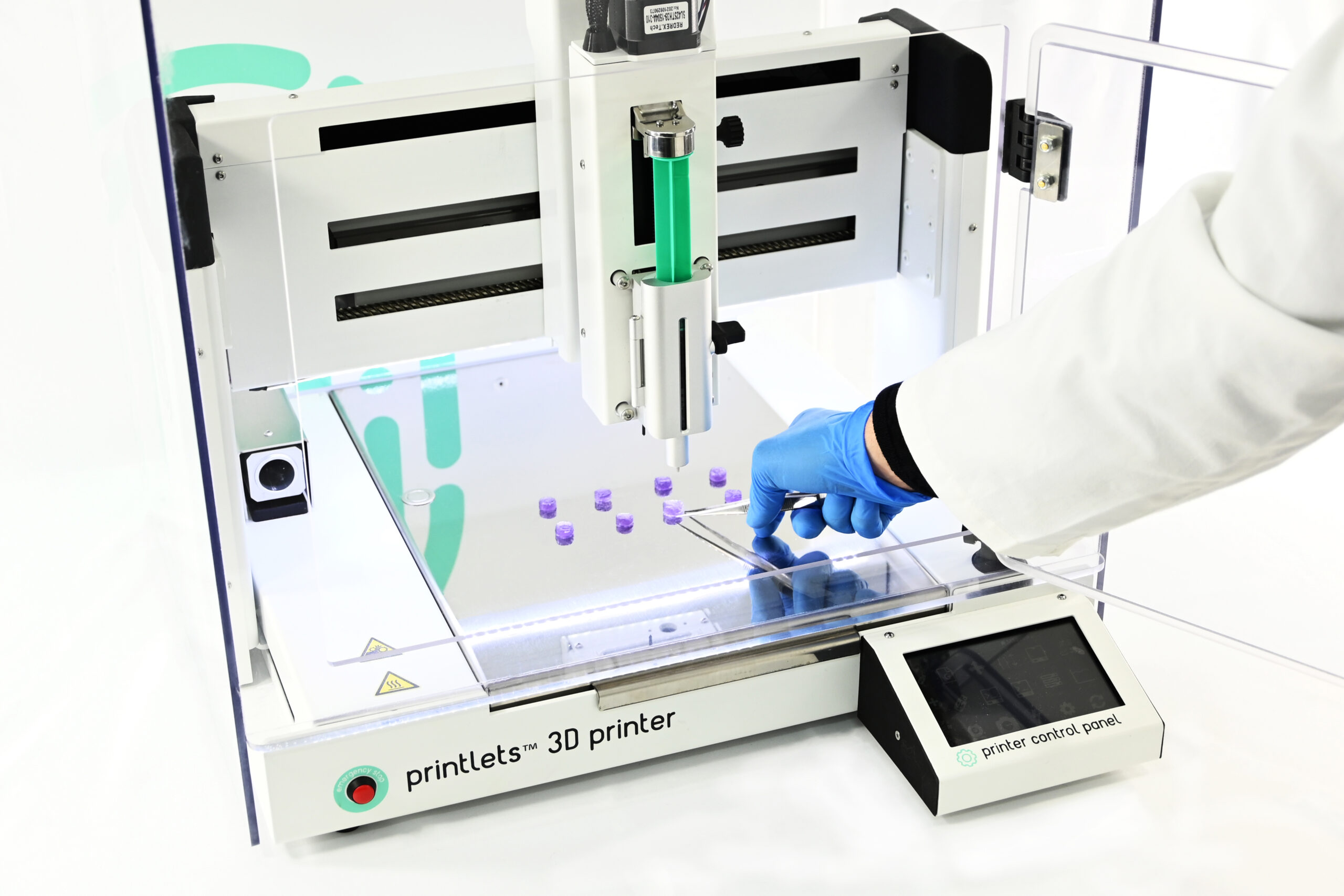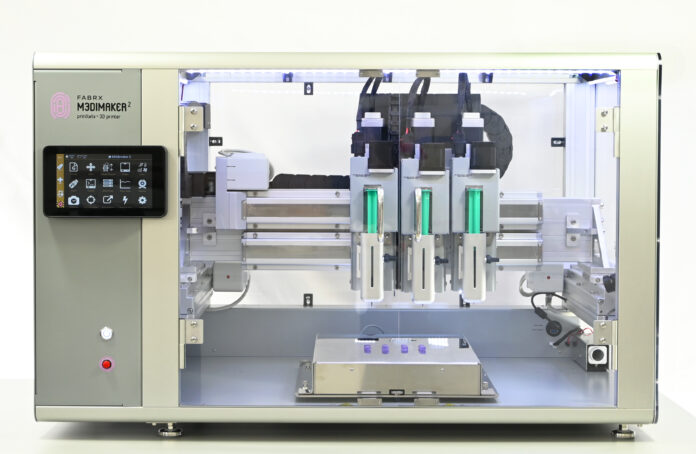One of the great complexities in projecting the prescription drug benefit costs for future benefit years lies in tracking new therapies in the pharmaceutical development pipeline and anticipating both their release date and the market dynamics (including price), and how they might affect the utilization and cost-per-unit factors. This complexity is amplified with the manufacturing of small batches of drugs with adjusted (and sometimes personalized formulation).
Indeed, when we look at the manufacturing process of drugs, conventional production processes rely on large-scale batch manufacturing, which is very efficient at churning out large volumes of drugs with uniform characteristics. However, these processes fail to meet time and cost requirements for small batches of drugs often needed for clinical trials. As you may know, Additive Manufacturing is uniquely positioned to meet these requirements since it enables the small-scale production of medications, in a relatively short time.
Here is the thing, as seen with applications across other industries, the use of AM for pharmaceuticals started in research laboratories. As the technology is carving out a substantial place within clinical and general hospitals, one needs to realize the pivotal role of legislation and certification in their adoption at scale and understand the different factors that may slow down the development of the 3D pharma printing market.
The dossier below ambitions to shed light on this go-to-market procedure as well as the key applications that 3D printing currently enables in this field of activity.
To discuss this topic, we invited Aprecia’s CEO Owen Murray and Dr. Anna Worsley, Director of Innovation at FabRx to share their experience of 3D pharma printing.
Headquartered in the US, Aprecia Pharmaceuticals addresses unmet healthcare needs leveraging commercial scale 3D Printing for pharmaceutical manufacturing. Headquartered in the UK, FabRx is a biotech company that focuses on developing 3D printing technology for fabricating pharmaceuticals and medical devices.
Production and commercialization of 3D printed medicines
When one does not directly work in the field, the first thing that may come to mind when talking about launching a new drug, is advertising and promotion. Yet, in this field, a crucial understanding of the drug development process, clinical applications, FDA or EMA approval is necessary.
The drug development process is a set of steps that medical researchers and companies take to generate new medicines, treatments, or diagnostic tools to treat or prevent diseases. Interestingly, one could have thought that this process would be much more complicated for 3D printed drugs – given the “novelty” of the technology in a vital industry like this one. It turns out it is not:

“3D printed pharmaceutical products do not have a special path to approval in the United States. The same pathways apply for both traditional manufacturing and Additive Manufacturing. So, the process for an NDA or an ANDA is no different than product candidates manufactured by traditional technology. That said, careful construction of an acceptable clinical trial protocol with broad dosing range is needed to accommodate customized precision dosing based on individual patient need”, Owen Murray states from the outset.
Although the same pathways apply for both traditional manufacturing and Additive Manufacturing, Dr. Anna Worsley believes that current legislation doesn’t fit 3D printed drugs. Leading regulatory bodies such as the FDA, EMA and MHRA are working on new legislation for point-of-care manufacturing to help make 3D printing at the point of care for personalized medicine more accessible. In the meantime, pharmaceutical and other medical technology companies are working on the enhancement of new formulations for 3D printed drugs.

“At the moment, many drug dosages are already personalized via pharmaceutical compounding in specialist pharmacies around the world. Using this method, you can develop the new 3D printable formulation, carry out quality control assessments and then integrate it into your compounding workflows. To commercialize one of these formulations, or intermediate products, you would need to work with a 3D printer supplier such as FABRX and regulatory bodies for printing reliability and patient safety across different printing sites”, Dr. Anna Worsley completes.
For pharmaceutical companies that are looking to explore AM, the most important challenges come at the level of production and the implementation of 3D printing. While drug dosages, drug combinations, release profiles and even flavors can be personalized with defined printing parameters, these advantages do not always answer the “mass customization” concern that may lead to strong profitability for pharmaceutical companies.
“Mass customization is possible”, Worsley notes. “However, it will take much more field development and market growth for this to happen. Also, only drugs that need personalizing will be personalized. For example, drugs with a narrow therapeutic index will probably be the ones entering the market first and drugs like paracetamol will never be personalized. In the future, polypills combining your daily pills into 1 would also be very beneficial for many people on complex poly-pharmacy prescriptions.”
Beyond the economic concern, another important aspect to take into consideration is medication prescription and administration. Since 3D printing may enable the integration of several formulations into one single drug, does it change the “standard” prescription protocols? Are healthcare professionals able to reduce medication errors and harm by respecting the five rights: the right patient, the right drug, the right dose, the right route, and the right time?

According to Murray, “once a product is approved for optimized dosing based on the individual needs of a patient suffering with a particular disease or disorder, the healthcare professional would not be required to change their current medication prescribing practice. Likewise, patients would not experience any change in the way they receive medications. Aprecia envisions a similar approach to how specialty medications are prescribed and dispensed. This often includes various hub services such as reimbursement support and clinical care guidance. The new piece would be the addition of a bespoke cGMP-compliant pharmaceutical manufacturing capability enabled by Aprecia’s proprietary 3DP technologies”.
“For medication that is already personalized via compounding, prescriptions can in theory stay the same. However, 3D printing increases the personalization options, meaning you can get an even more precise dosage, and personalize things like color and flavor. This would require additional prescription details but would benefit some patients massively. For drugs not already personalized, obviously the prescription would become more complex, but with the benefits that 3D printing offers, the treatment should be more effective overall”, FabRx’ Director of innovation highlights.
Lastly, the cost. In general, using AM for tailor-made applications has often proven to be more expensive than other mass-produced products using conventional manufacturing processes. We are tempted to think that the 3D pharma printing market is no exception to this theory, but our experts want to remain cautious:
“Like any pharmaceutical product, the cost to the patient will ultimately depend upon the unmet medical need being addressed, the clinical benefit of the product, and the level of payer reimbursement. This is largely driven by the pharmacoeconomic value proposition of the product. With respect to COGs, a comparison between technologies is not directly one-to-one. Aprecia’s 3DP manufacturing technologies are often enabling and help pharmaceutical companies solve problems beyond the capabilities of traditional manufacturing technologies. 3D-printed products are often more complex and thus have different pricing components to be considered. Additive Manufacturing is competitive with other enabling manufacturing technologies for pharmaceuticals. However, the potential for supply chain efficiencies may result in significant cost savings”, Aprecia’s CEO shares.
“We foresee 3D printing to be cheaper than the current compounding methods used to personalize medicine, as it automates the process, freeing up staff time. It will be more expensive than mass manufacturing, although these higher expenses will be worth it down the line with more effective treatments, reduced hospitalizations and reduced waste”, FabRx’ expert adds.
Are the applications worth the final cost then?
A wide range of drugs can be fabricated using 3D printing technologies. They include, for instance, drugs with a narrow therapeutic index, especially in high-risk patient groups such as pediatrics, or with high risks for side effects.
With respect to precision dosing, the production of drugs using 3D printing can provide significant advantages for patients suffering from rare and orphan diseases. Onerous dosing regimens are not uncommon when treating such diseases and the pill burden can be extremely challenging.
“One major advantage provided by Aprecia’s 3DP technologies and our ZipDose formulation platform is drug delivery via tablets that disintegrate very rapidly with a small sip of liquid regardless of the weight. For example, Aprecia won FDA approval for a 1000 mg strength orodispersible tablet, which is much larger than any strength approved as an ODT product. This benefits patient populations that suffer from dysphagia, or difficulty swallowing. In addition to children, the elderly, and special needs patients, dysphagia is common in certain therapeutic areas such as neurology, psychiatry, oncology, and gastroenterology. Spritam®, Aprecia’s FDA-approved 3DP product, is prescribed to treat epilepsy”, Murray enthuses.
That said, it should be noted that Aprecia received FDA approval for a 3D printed drug in 2015 and has had the product available on the commercial market since 2016. The product Spritam is manufactured in Aprecia’s ZipDose to provide an easy-to-swallow tablet for Epileptic patients. ZipDose is a specialized tablet created using Additive Manufacturing that rapidly disintegrates with a small sip of liquid. The rapid disintegration enables much larger dose sizes to be easily swallowed by patients.
In the meantime, the team at FabRx is currently involved in over 4 clinical studies and trials, with many more in the pipeline. So, hopefully, one might hear some good news from them in the upcoming months.
Moving forward, the company believes that if large pharmaceutical companies get involved and develop their own formulations of medicines using 3D printing, this might help propel the 3D pharma printing market forward.
Notes for the readers:
Aprecia combines the layer-by-layer precision of 3DP and the unique needs of individual patients to deliver optimized dosing from the start of clinical trials through product commercialization. Digital precision enables the deposition of two separate powder blends and two different liquid blends enabling each layer of the 3D-printed tablet to be customized and adjusted as needed with respect to API, API and intermediates, API multiparticulates, and/or API dose. Aprecia’s 3D-printed tablets are manufactured in primary packaging which enables tablet-level identification and traceability from first-in-human formulations to final dosage forms with minimal scale-up, the potential to scale out and commercial volume production capabilities. Aprecia believes its technology can be centralized or distributed and still maintain cGMP compliance.
FabRx believes in a world where medical treatment can be personalized to the individual needs of each patient (in terms of dosage, shape, size and dose combinations) for production on-site in pharmacies or clinical trial units. In this way, medicine taking is easier, more effective and associated with better patient outcomes. To achieve its goal, the company explores the use of several 3D printing technologies through their partnerships with healthcare institutes.







